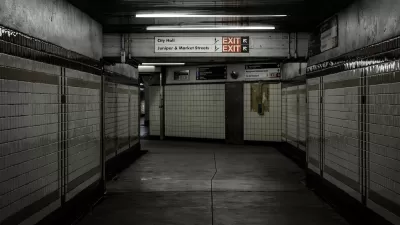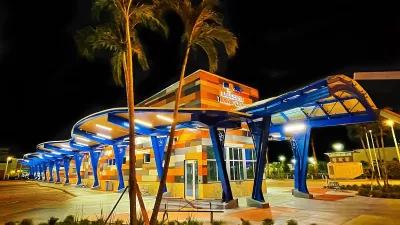As ridership dropped during the pandemic, Philadelphia's transit agency started locking station doors to keep unhoused people from using the tunnels as shelter. Now, riders are becoming trapped inside.

Describing the experience of one rider with a disability that forces her to minimize walking, Jake Blumgart outlines how new security measures on Philadelphia's SEPTA trains are trapping riders who now have to walk much longer distances to accessible exits or are unable to enter or exit stations altogether. "The agency confirmed at least 10 riders have been trapped in the tunnels after walking through a one-way turnstile, only to find doors to the street barred and locked."
To explain: "Center City’s rail stations are connected to a vast, and confusing, concourse system that runs beneath the heart of downtown Philadelphia. As commuter and tourist traffic vanished with the pandemic in 2020, people living on the streets increasingly used the tunnels as shelter. SEPTA closed access points and cordoned off huge sectors of the underground."
Now, writes Blumgart, "SEPTA is spending millions to contract with social service organizations to help address the issue, but the new maze of mysteriously locked doors, gated exits, and other unfriendly impediments are making the system less accessible for everyone." SEPTA has pledged to reopen some areas and provide more clear signs explaining closures. Yet "Several riders interviewed for this article found them confusing, if less inscrutable than their absence was last year."
Transit systems in other cities are experiencing similar stresses, with varied responses. "In a December 2020 survey of 115 transit agencies, half said they had experienced a surge in homeless ridership." With ridership still far below pre-pandemic levels and budgets strained, the agencies are struggling to implement new programs to offer social services and make riders feel safe.
FULL STORY: Riders are getting trapped in rail stations after SEPTA ‘hardens’ the system to keep out unhoused people

Study: Maui’s Plan to Convert Vacation Rentals to Long-Term Housing Could Cause Nearly $1 Billion Economic Loss
The plan would reduce visitor accommodation by 25,% resulting in 1,900 jobs lost.

North Texas Transit Leaders Tout Benefits of TOD for Growing Region
At a summit focused on transit-oriented development, policymakers discussed how North Texas’ expanded light rail system can serve as a tool for economic growth.

Why Should We Subsidize Public Transportation?
Many public transit agencies face financial stress due to rising costs, declining fare revenue, and declining subsidies. Transit advocates must provide a strong business case for increasing public transit funding.

How to Make US Trains Faster
Changes to boarding platforms and a switch to electric trains could improve U.S. passenger rail service without the added cost of high-speed rail.

Columbia’s Revitalized ‘Loop’ Is a Hub for Local Entrepreneurs
A focus on small businesses is helping a commercial corridor in Columbia, Missouri thrive.

Invasive Insect Threatens Minnesota’s Ash Forests
The Emerald Ash Borer is a rapidly spreading invasive pest threatening Minnesota’s ash trees, and homeowners are encouraged to plant diverse replacement species, avoid moving ash firewood, and monitor for signs of infestation.
Urban Design for Planners 1: Software Tools
This six-course series explores essential urban design concepts using open source software and equips planners with the tools they need to participate fully in the urban design process.
Planning for Universal Design
Learn the tools for implementing Universal Design in planning regulations.
Ascent Environmental
Borough of Carlisle
Institute for Housing and Urban Development Studies (IHS)
City of Grandview
Harvard GSD Executive Education
Toledo-Lucas County Plan Commissions
Salt Lake City
NYU Wagner Graduate School of Public Service




























